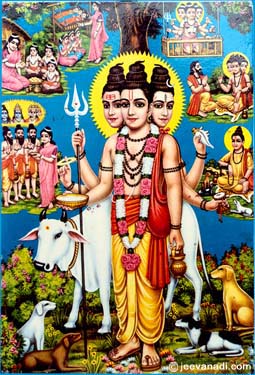The Nāth Sampradāya today comprises an order of renunciate ascetics and a householder caste, both of which trace their lineages to a group of nine Nāth gurus headed by Ādinātha (“First Nāth”), who is identified with the god → Śiva. Next in most lists of nine Nāths comes Matsyendranātha, followed by Goraksanātha (Gorakhnāth), who is said to have founded the Nāth order of ascetics. The earliest references to the Nāth ascetic order as an organized entity date to the beginning of the 17th century, but its first historical gurus, Matsyendranātha and Goraksanātha, lived much earlier, probably in the 9th and 12th centuries, respectively, and during the intermediate period there are numerous references to both ascetic and householder Nāths in texts, inscriptions, iconography, and historical reports.
In this article, thefeatures that characterize the Nāth Sampradāya today will be summarized (for a more detailed ethnography of today’s Nāths, see Bouillier, 2008; see also → Kānphatās), followed by an examination of their historicity: Nāths today claim that their characteristics were introduced by Goraksa when he founded the Sampradāya, but many are of more recent origin. Aspects of Nāth identity that are shared with other groups, such as the Nāth ascetics’ observance of typical Hindu renouncers’ vows (see → sādhus), will not be examined in detail.
Today the ascetic branch of the Nāth Sampradāya is quite distinct from that of the householders. Membership of the former is open to all and effected by initiation from an ascetic Nāth guru. Householder Nāths greatly outnumber asceticsand consist of a broad variety of mainly endogamous castes. They see themselves as descendants of Nāth ascetics who broke their vows of celibacy and settled down as householders. Householder Nāths are found throughout India and Nepal, with certain regions, such as Karnataka, Rajasthan, West Bengal, Uttar Pradesh, Uttarakhand, and Nepal, having higher concentrations than others. The various householder Nāth castes include a wide range of social groups, from lowstatus Muslim bards in Uttar Pradesh and Bihar to relatively high-status Sanskritized jogīs (Hind. yogī) and Nāths in → Rajasthan and → Karnataka, respectively.
The ascetic Nāth order is overseen by an organization called the Akhil Bharatvarshiya Avadhoot Bhesh Barah Panth Yogi Mahasabha (“The All-Indian Great Assembly of the Renunciate Yogis of the Twelve Lineages”), which was founded in 1906 and whose headquarters are in Haridwar. There are approximately eight to ten thousand Nāth ascetics in India today (Bouillier, 2008, 15). Their monasteries, which number about f ive hundred, are found mostly in northern and western India. There are also a handful of monasteries in each of the following regions of the subcontinent: Bihar, Bengal, Assam, Orissa, Andhra Pradesh, Karnataka, Nepal, and Pakistan.

In this article, thefeatures that characterize the Nāth Sampradāya today will be summarized (for a more detailed ethnography of today’s Nāths, see Bouillier, 2008; see also → Kānphatās), followed by an examination of their historicity: Nāths today claim that their characteristics were introduced by Goraksa when he founded the Sampradāya, but many are of more recent origin. Aspects of Nāth identity that are shared with other groups, such as the Nāth ascetics’ observance of typical Hindu renouncers’ vows (see → sādhus), will not be examined in detail.
Today the ascetic branch of the Nāth Sampradāya is quite distinct from that of the householders. Membership of the former is open to all and effected by initiation from an ascetic Nāth guru. Householder Nāths greatly outnumber asceticsand consist of a broad variety of mainly endogamous castes. They see themselves as descendants of Nāth ascetics who broke their vows of celibacy and settled down as householders. Householder Nāths are found throughout India and Nepal, with certain regions, such as Karnataka, Rajasthan, West Bengal, Uttar Pradesh, Uttarakhand, and Nepal, having higher concentrations than others. The various householder Nāth castes include a wide range of social groups, from lowstatus Muslim bards in Uttar Pradesh and Bihar to relatively high-status Sanskritized jogīs (Hind. yogī) and Nāths in → Rajasthan and → Karnataka, respectively.
The ascetic Nāth order is overseen by an organization called the Akhil Bharatvarshiya Avadhoot Bhesh Barah Panth Yogi Mahasabha (“The All-Indian Great Assembly of the Renunciate Yogis of the Twelve Lineages”), which was founded in 1906 and whose headquarters are in Haridwar. There are approximately eight to ten thousand Nāth ascetics in India today (Bouillier, 2008, 15). Their monasteries, which number about f ive hundred, are found mostly in northern and western India. There are also a handful of monasteries in each of the following regions of the subcontinent: Bihar, Bengal, Assam, Orissa, Andhra Pradesh, Karnataka, Nepal, and Pakistan.

No comments:
Post a Comment